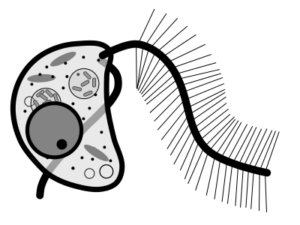 Hosts: Vincent Racaniello, Dickson Despommier, Alan Dove, Rich Condit, and Kathy Spindler
Hosts: Vincent Racaniello, Dickson Despommier, Alan Dove, Rich Condit, and Kathy Spindler
The TWiVrific gang reveal how integration of a virophage into the nuclear genome of a marine protozoan enhances host survival after infection with a giant virus.
Click arrow to play
Download TWiV 419 (64 MB .mp3, 105 min)
Subscribe (free): iTunes, RSS, email
Become a patron of TWiV!
Links for this episode
- Microcephaly associated with Zika virus infection in Colombia (MMWR) 17:45
- Virophage genome integration and activation by superinfection (Nature) 20:00
- Don Nelson interview (pdf) 51:26
- Page view and h index for paper rank (PLoS One) 1:11:25
- Credit for image of C. roenbergensis
- Letters read on TWiV 419 7:30, 47:35, 51:05
This episode is brought to you by CuriosityStream, a subscription streaming service that offers over 1,400 documentaries and nonfiction series from the world’s best filmmakers. Get unlimited access starting at just $2.99 a month, and for our audience, the first two months are completely free if you sign up at curiositystream.com/microbe and use the promo code MICROBE.
Weekly Science Picks 1:26:00
Alan – Lab Wars
Dickson – Star in a Jar Fusion Reactor
Rich –You’re a Bee. This is What it Feels Like.
Kathy – List of Potential Predatory Journals
Vincent – CRISPR Patent Trial Begins
Listener Pick
Drake – Spinzall
Katreya – Periodic Videos
Pritesh – Smallpox in mummy
Send your virology questions and comments to twiv@microbe.tv


Let me start by expressing my appreciation for the TWiV podcasts. As a non-scientist, I find them interesting and educational, even when the science is far exceeds my understanding.
In TWiV 419, Rich Condit read an email about the 1950 release of Serratia marcescens over San Francisco. There are some problems with the news account, and I felt compelled to offer a corrective comment.
I don’t want to discuss the plausibility of a linkage between the Army disseminated Serratia marcescens off the coast of San Francisco and the nosocomial outbreak. The evidence to support the connection is extremely weak, but discussing that is off topic (not related to viruses), so I won’t go into the details of why (except to note most scientific reviews are skeptical of the linkage).
My main point is the inappropriateness of applying 2016 standards of behavior to events that occurred half a century before. While no one in a position of responsibility would conduct such a test today, what the Army did was not inconsistent with the standards of the time.
It is important to recognize that there was outside oversight of the Army’s actions, specifically an outside scientific advisory panel that included experts from outside the Defense Department. Among them was Dr. Alexander Langmuir, then just starting his long career at CDC. Today, Langmuir is considered one of the icons of American (perhaps global) public health, but is best remembered for organizing the Epidemic Intelligence Service. Of specific importance to this case, Langmuir also was one of the world’s leading authorities on airborne infection. In other words, this was not some rogue operation conducted by functionaries hiding behind a veil of secrecy.
More significantly, and perhaps something that academics should be sensitive to, the Army’s actions was consistent with the behavior of academic scientists. A 1979 review article by Victor Yu in the New England Journal of Medicine reports on 4 articles that describe use of S. marcescens as a biological marker in human experiments. In 2011, Steven Mahlen discussed numerous similar examples in a review article. As late as 1970, a letter appeared in Science complaining that laboratory manuals still recommended coating the hands of students with a solution of S. marcescens to demonstrate contact transmission of microorganisms.
Hence, the Army practice was reflective of the broader practice of the scientific community at the time. While the San Francisco tests should not have taken place, we also now know that neither should these other practices have occurred, conducted as they were by members of an expert community of scientists who should have known better.
As I write, it is a relatively balmy 6 degrees C (44 F) in Baltimore.
Mahlen, Steven D. “Serratia Infections: From Military Experiments to Current Practice.” Clinical Microbiology Reviews 24, no. 4 (October 2011): 755–91. doi:10.1128/CMR.00017-11.
Yu, Victor L. “Serratia Marcescens: Historical Perspective and Clinical Review.” New England Journal of Medicine 300, no. 16 (1979): 887–93.